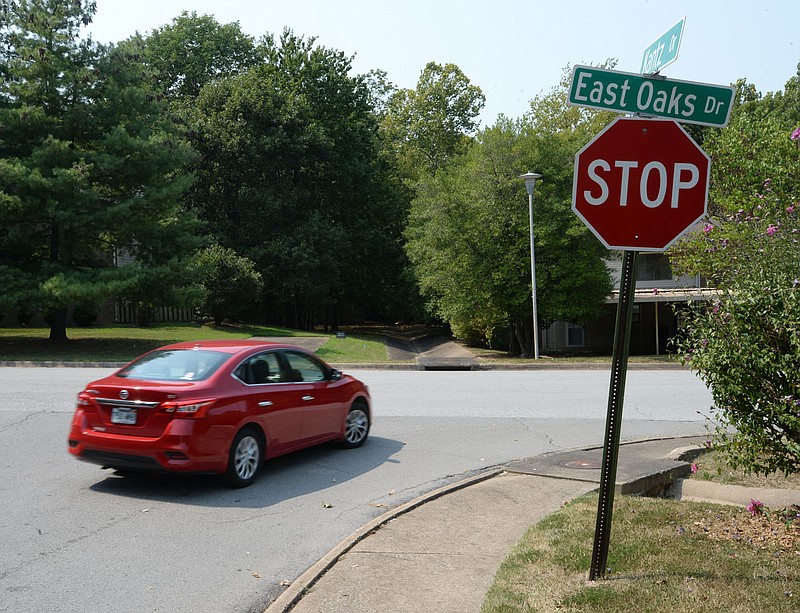FAYETTEVILLE -- The city will soon install its first neighborhood traffic-calming project under a new policy requiring residents' approval and an evaluation of traffic data.
Speed cushions will be put in at seven spots along East Oaks and Kantz drives, southwest of Township Street and Crossover Road. Speed cushions serve as an alternative to concrete speed bumps and tables, which can damage emergency vehicles, and traffic circles, which can be hard for larger emergency vehicles to maneuver.
The cushions usually are made of hard rubber with wide gaps so the wheels of fire trucks can pass through. Cars still have to run over them.
The City Council updated the city's policy on traffic calming -- or getting cars to go slower in neighborhoods -- late last year. The updated policy uses traffic data and a point system to prioritize requests and leaves it up to neighborhoods to initiate and review a project.
The city has been using a point system since 2003, but the threshold to approve a project was higher, said Public Works Director Chris Brown. Data used to score points included speed and number of cars per day, yearly accidents, proximity to schools and whether the streets have sidewalks. Neighborhoods scoring 35 points or above are considered for traffic calming under the updated policy. The number was 60 points before, he said.
The city installed 53 speed tables by March 2008, according to a report in the Northwest Arkansas Times. Some of the tables, such as ones near Wilson Park or in the Washington-Willow neighborhood, didn't meet the point threshold but were installed because of resident complaints, Brown said.
There were other streets on a list that never came to fruition. Money for traffic calming in neighborhoods was cut when the recession hit in 2009, he said.
At least 70% of households on a street that might get a traffic-calming measure installed must agree to the idea. Once city staff designs a plan, 60% of the households on the street have to approve it. Each house gets one vote.
The city used to have a similar policy in 2004. A resident could initiate a traffic study with a petition signed by 75% of households on the street. The policy changed in 2005, allowing city staff to start a traffic study with a single request from a resident, according to the Times.
The council updated the policy last year and allocated money toward the issue. Speeding cars in neighborhoods is one of the most frequent complaints the city receives, Brown said.
"For almost 10 years, we were taking requests, we just didn't have any funding, and we didn't have a mechanism to get anything done," he said.
The process
Residents who want to apply for traffic-calming consideration can fill out a form online. The resident who made the request is sent a link to an online survey to share with neighbors. If 70% of households agree, the city will collect traffic data. If the request meets the points threshold, the city will present a plan to the neighborhood. If 60% of households like the plan, it will go before the City Council's Transportation Committee for consideration.
The committee approved the East Oaks Drive project Aug. 31. The city has ordered the materials and should install the speed cushions within a few weeks, said Dane Eifling, the city's mobility coordinator.
Estimated cost of the project is $18,900 for the seven cushions. There's $60,000 for traffic-calming projects included in the council-approved transportation budget this year.
The next projects on the list are Elizabeth Avenue from Rolling Hills Drive to Stanton Avenue and New Bridge Road within the Bridgeport subdivision southwest of Mount Comfort Road and Rupple Road. The city already has traffic data for those areas from previous studies, and they meet the point threshold, Eifling said. Residents are working on the online surveys and appear likely to gain the necessary signatures, he said.
The city already has traffic data for 15 streets that meet the point threshold from studies done in past years, Eifling said. Those streets don't have requests pending, but it's possible the city may reach out to those neighborhoods if there is money to spare, he said.
There are another 16 streets that could potentially meet the point threshold and have requests made, but only a few signatures on a petition, Eifling said. Another five streets got enough signatures on their petitions, but don't meet the city's point criteria, he said.
Another option
Scott Mashburn lives in a neighborhood on North Highland Avenue, east of Wilson Park, that got enough signatures but didn't meet the city's scoring criteria. Not enough cars passed through the area, according to city staff. Mashburn addressed the Transportation Committee about his request Aug. 31.
There's another option for residents such as Mashburn. The city has what it calls its Tactical Urbanism program, which enables residents to install impermanent traffic-calming measures themselves with city approval. The difference is the city may loan the residents materials such as traffic cones or reflective vests, but the neighborhood fronts most of the cost. BikeNWA, the city's nonprofit partner for its Tactical Urbanism program, also has some materials available such as paint, rubber blocks or concrete planter boxes, Eifling said.
Approval for a yearlong Tactical Urbanism project on North Highland Avenue is pending. Once approved, the city will monitor traffic in the area and determine whether a permanent installation is warranted, Eifling said.
Mashburn told the committee he appreciated the city giving residents a say when it comes to traffic in their neighborhood.
"I think it's progress," Mashburn said. "It's getting buy-in from the neighbors."


More News
How to apply
Residents can apply for traffic calming in their neighborhood at:
http://bit.ly/faytr…" target="_blank" title="http://bit.ly/faytr…">http://bit.ly/faytr…

